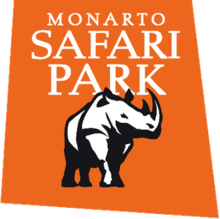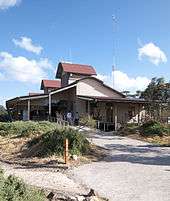Monarto Safari Park
Monarto Safari Park, formerly known as Monarto Zoological Park and Monarto Zoo, is a 1,500-hectare (3,700-acre) open-range zoo located in South Australia administered by the Royal Zoological Society of South Australia. It is located at Monarto, approximately 70 kilometres (43 mi) from Adelaide's centre.
 | |
| Date opened | 1983 |
|---|---|
| Location | Monarto, South Australia |
| Coordinates | 35.1021°S 139.1424°E |
| Land area | 1,500 hectares (3,700 acres)[1] |
| Website | Monarto Safari Park |
The zoo features several unique attractions, including opportunities to get close to lions and cheetahs, and have interactive experiences with meerkats, a Southern White Rhinoceros and a Black Rhinoceros, and see Australia's largest giraffe herd.
History

The zoo was created in 1983 on land owned by the state government as a closed-to-the-public, purpose breeding area and endangered species sanctuary. In 1990, a study was undertaken to determine the feasibility of allowing public access to the zoo, and by 1993 it had been developed into a large educational facility, open to the public, with bus and walking tours.
Five major habitat exhibits have been developed, including the Asian steppes, arid north Africa, African plains, and Asian grasslands. The entire zoo is surrounded with vermin-proof fencing to keep the habitat as self-contained as possible. The area is not irrigated, and is populated primarily with native flora to cut down on water consumption and erosion in the semi-arid region. The roads and trails within the zoo are constructed of local materials to keep them low maintenance, and to allow them to be easily re-integrated into the habitat should the need arise. Waste water is recycled, and as much as possible, solar power is used for electric fencing needs.
In late 2019, Monarto Zoo began a three-year project to convert itself into a safari park with luxury resort facilities. As part of the overhaul, it is transitioning its branding to be "Monarto Safari Park" by 2021.[2] Monarto will also become the largest park outside of Africa.[3]
Description
Monarto Safari Park is an open-range zoo comprising 1,500-hectare (3,700-acre)[1] administered by the Royal Zoological Society of South Australia(trading as Zoos SA)[4] and located near Monarto, South Australia.
Conservation efforts

Endangered species
The zoo is taking part in numerous conservation efforts with endangered species, and has breeding projects for many Australian native species, including the greater bilby, the tammar wallaby, the yellow-footed rock-wallaby, and the eastern barred bandicoot, as well as many exotic species, including the scimitar oryx, Przewalski's horse, American bison, the addax, Barbary sheep, South African cheetah, southern white rhinoceros, black rhinoceros and the African wild dog.
In 2006, the zoo began a breeding program for Tasmanian devils which are free of facial tumour disease.[7]
Previously widespread throughout the ranges of central Australia, the warru, or black-footed rock-wallaby, is as of July 2019 South Australia's most endangered mammal, primarily due to predation by foxes and feral cats. However Monarto has had some success in breeding the wallabies since the capture of 15 of them in 2007, and has helped to establish a viable population (22) of the wallabies in a 1 square kilometre (0.39 sq mi) fenced area, known as the Pintji, in the Anangu Pitjantjatjara Yankunytjatjara (APY) Lands lands. In June 2017 Monarto announced that 25 of the population bred at Pintji, along with 15 others, had been released into the wild. These will be monitored and feral animal control measures are in place.[8]
Ethical products
On-site shops and catering facilities at the zoo actively avoid using products containing palm oil.[9] Visitors are encouraged to go palm oil free and provided information on how to go about it.
See also
References
- "Zoos South Australia: Adelaide & Monarto Zoo". Retrieved 1 April 2016.
Monarto Zoo is the largest open-range zoo in the world spanning more than 1,500 hectares and home to more than 500 animals and 50 species.
- "Monarto Safari Park - becoming the world's largest safari outside Africa". Monarto Safari Park. Retrieved 20 October 2019.
...from today onwards you can refer to us as Monarto Safari Park.
- https://www.adelaidenow.com.au/subscribe/news/1/?sourceCode=AAWEB_WRE170_a_GGL&dest=https%3A%2F%2Fwww.adelaidenow.com.au%2Flifestyle%2Fsa-weekend%2Fthe-multimilliondollar-plan-to-bring-africa-to-adelaide%2Fnews-story%2Ff4249bef951fe0ceedc203cb61e25ad6&memtype=anonymous&mode=premium
- "Terms and Conditions - Membership". Zoos SA. Retrieved 5 July 2015.
- Tom Fedorowytsch and staff (18 September 2015). "Asali the giraffe arrives at Monarto Zoo after Nullarbor crossing". ABC News. Australian Broadcasting Corporation. Retrieved 15 October 2015.
- "Giraffe". Monarto Safari Park. 23 September 2019.
- "Monarto Zoo hopes for more Tasmanian devils breeding program success". ABC News. Australian Broadcasting Corporation. 17 February 2015. Retrieved 15 October 2015.
- Tucker, Alyssa-Jane (8 June 2017). "Safeguarding South Australia's most endangered mammal". Monarto Zoo. Retrieved 12 July 2019.
- Fa, John E.; Stephan M. Funk; Donnamarie O'Connell (2011). Zoo Conservation Biology. Cambridge University Press. p. 232. ISBN 1139498622. Retrieved 15 October 2015.
External links
- Official website
